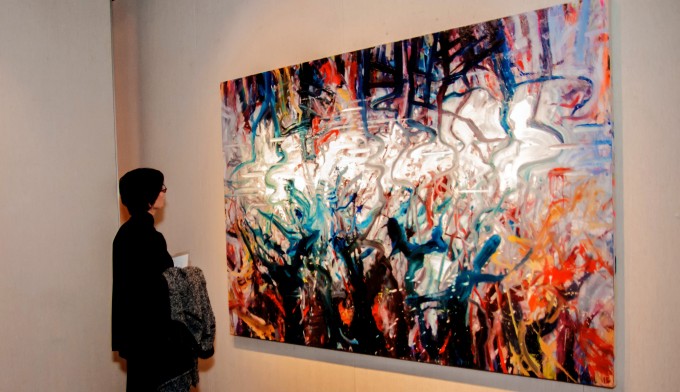Where Light enters the Mind
As a young, aspiring painter, before I had any idea that Rick Vian was a local artist, I greedily snipped out every advertisement from Art in America his work was featured in and collaged them into my journal, alongside the work of other painters who inspired me. I loved the way his work rode a Rothko-esque razor’s edge between abstraction and representation (channeling Rothko as well in subjective spiritual punch) and how smartly it appropriated recognizable phenomena that were already abstract, such as reflections and strange effects of atmosphere and light, into works that were as much about form and surface as they were about content and illusion. Seeing Vian’s recent work this week, therefore, felt doubly special- being surrounded by masterful, imposingly scaled paintings that come from a body of work I’ve followed closely for years.
The title of Rick Vian’s retrospective, currently on view at Robert Kidd Gallery in Birmingham- Using the Whole Chicken– belies the perceptive, multi-layered formal gravitas that unfolds as one moves from piece to piece. Consisting of paintings spanning 1972 to 2015, Using the Whole Chicken, takes as its prima materia two iconic spiritual forms from two vastly different faiths- the Western Baroque genre of trompe lois church ceiling paintings (Vian mentions two ceilings in Roman churches in his artist statement, painted by Giovanni Battista Gauli and Andrea Pozzo) and the Eastern mandala (or mandorla, which, as Vian points out, appears in early esoteric Christian and Islamic art as well). Both forms seek to foster a transcendent spiritual experience, delivered visually- Both consist, very basically, of a round, bright center surrounded by darkness. Vian takes this visual coda of contemplation and transcendence outward, into nature, and inward, into the visual cortex of the human brain- an interesting conceptual mirror for the outer journey of Western painting, with its focus on beauty, perspective, and high illusion, versus the inner path of Eastern aesthetics with its deceptively simple abstractions and vague, groundless atmospherics that channel a more subjective, synesthetic experience of the world.
Vian’s great gift as a painter is his apparently effortless ability to conjure images that are at once fully nonobjective and grounded in depth- windows onto the world in the Italian Renaissance tradition. The paintings in Using the Whole Chicken appear before the viewer’s eyes as formal abstractions, while creeping up behind the eyes as atmospheric landscapes. Their surfaces are formal, their deeper implications illusionistic. The more time one spends with a Rick Vian painting, the more subtle, ungrounding, and revelatory this interplay becomes.
It’s appropriate that Vian has chosen to frame the work in Using the Whole Chicken in terms of iconic spiritual image systems- he’s picked the beauty, turgid hues, and attention to surfaces from Western painting and the subjective, unfixed viewpoint and groundless atmospherics from Eastern painting, roping in references to the inner processes of the brain into the mix. The honeycomb-like grids that appear here and there in the work represent the process by which light enters the visual cortex of the human brain and is broken up into colors, shapes and space- another symbolic connection to the traditions of church ceiling painting and the mandorla, which Vian describes as “looking towards a place of light from a place of darkness.”
Using the Whole Chicken exhibition is on display at Robert Kidd Gallery in Birmingham, MI from 11/19/2015 – 12/19/2015. www.robertkiddgallery.com



